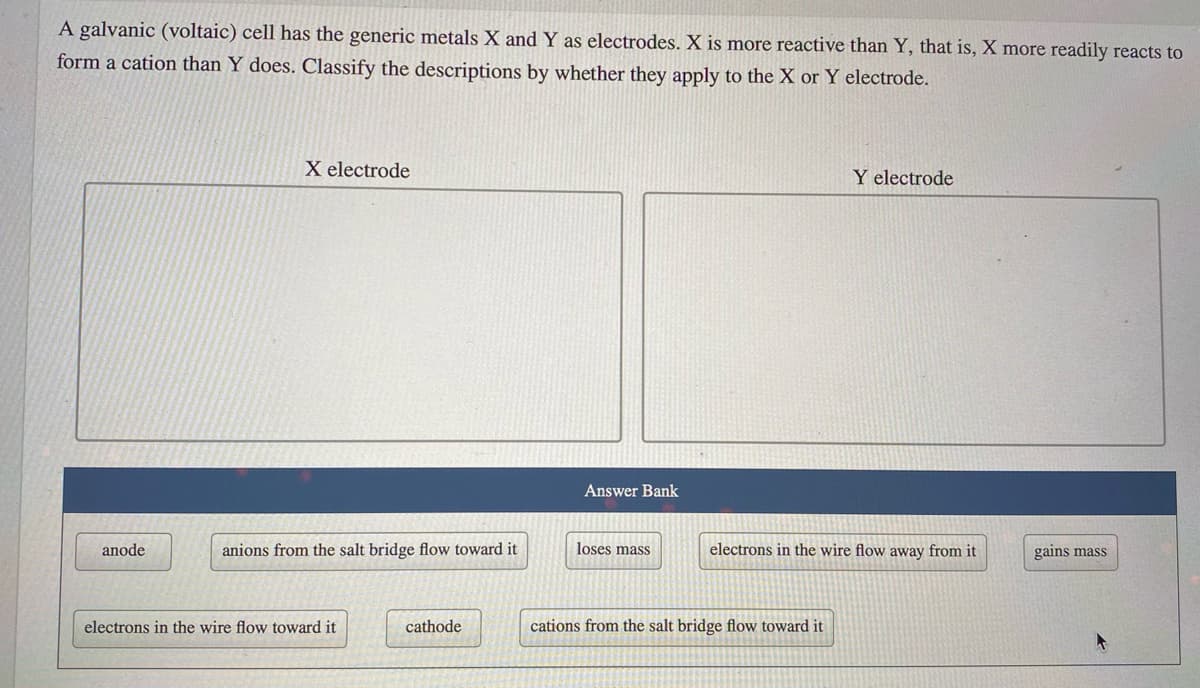A galvanic (voltaic) cell has the generic metals X and Y as electrodes. X is more reactive than Y, that is, X more readily reacts to form a cation than Y does. Classify the descriptions by whether they apply to the X or Y electrode. X electrode Y electrode Answer Bank anode anions from the salt bridge flow toward it loses mass electrons in the wire flow away from it gains mass electrons in the wire flow toward it cathode cations from the salt bridge flow toward it
A galvanic (voltaic) cell has the generic metals X and Y as electrodes. X is more reactive than Y, that is, X more readily reacts to form a cation than Y does. Classify the descriptions by whether they apply to the X or Y electrode. X electrode Y electrode Answer Bank anode anions from the salt bridge flow toward it loses mass electrons in the wire flow away from it gains mass electrons in the wire flow toward it cathode cations from the salt bridge flow toward it
Chemistry: Principles and Practice
3rd Edition
ISBN:9780534420123
Author:Daniel L. Reger, Scott R. Goode, David W. Ball, Edward Mercer
Publisher:Daniel L. Reger, Scott R. Goode, David W. Ball, Edward Mercer
Chapter18: Electrochemistry
Section: Chapter Questions
Problem 18.40QE: A voltaic cell is based on the reaction Zn(s)+Ni2+(aq)Zn2+(aq)+Ni(s) Voltage measurements show that...
Related questions
Question

Transcribed Image Text:A galvanic (voltaic) cell has the generic metals X and Y as electrodes. X is more reactive than Y, that is, X more readily reacts to
form a cation than Y does. Classify the descriptions by whether they apply to the X or Y electrode.
X electrode
Y electrode
Answer Bank
anode
anions from the salt bridge flow toward it
loses mass
electrons in the wire flow away from it
gains mass
electrons in the wire flow toward it
cathode
cations from the salt bridge flow toward it
Expert Solution
This question has been solved!
Explore an expertly crafted, step-by-step solution for a thorough understanding of key concepts.
This is a popular solution!
Trending now
This is a popular solution!
Step by step
Solved in 2 steps with 1 images

Knowledge Booster
Learn more about
Need a deep-dive on the concept behind this application? Look no further. Learn more about this topic, chemistry and related others by exploring similar questions and additional content below.Recommended textbooks for you

Chemistry: Principles and Practice
Chemistry
ISBN:
9780534420123
Author:
Daniel L. Reger, Scott R. Goode, David W. Ball, Edward Mercer
Publisher:
Cengage Learning

Principles of Modern Chemistry
Chemistry
ISBN:
9781305079113
Author:
David W. Oxtoby, H. Pat Gillis, Laurie J. Butler
Publisher:
Cengage Learning

Chemistry: An Atoms First Approach
Chemistry
ISBN:
9781305079243
Author:
Steven S. Zumdahl, Susan A. Zumdahl
Publisher:
Cengage Learning

Chemistry: Principles and Practice
Chemistry
ISBN:
9780534420123
Author:
Daniel L. Reger, Scott R. Goode, David W. Ball, Edward Mercer
Publisher:
Cengage Learning

Principles of Modern Chemistry
Chemistry
ISBN:
9781305079113
Author:
David W. Oxtoby, H. Pat Gillis, Laurie J. Butler
Publisher:
Cengage Learning

Chemistry: An Atoms First Approach
Chemistry
ISBN:
9781305079243
Author:
Steven S. Zumdahl, Susan A. Zumdahl
Publisher:
Cengage Learning

Chemistry
Chemistry
ISBN:
9781305957404
Author:
Steven S. Zumdahl, Susan A. Zumdahl, Donald J. DeCoste
Publisher:
Cengage Learning

